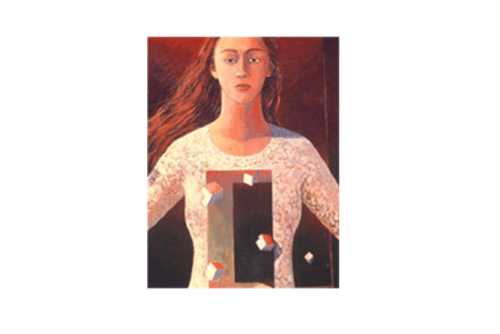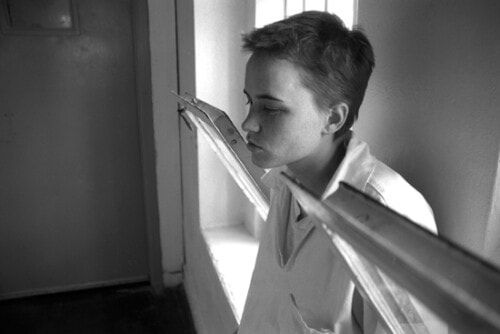Next, I’m going to read from the chapter called Harem.
“By the time my mother was a child, the practice of men’s having concubines had come to an end. But the attitudes underlying those bygone ways were not quite gone.
Even in my own childhood, Zatoun, my mother’s paternal home, was a place palpably apart, imbued with some unnamably different order of being. The aura and aroma of other times and other ways pervaded it still, in the rustle and shuffle of silks and the soft fall of slippers along hallways and corridors; in the talk and gestures in the momentary tremor of terror precipitated by the boom of my grandfather’s voice, and then the quiet, suppressed, chortling laughter of the women as the boom faded and he passed into the recesses of the inner hall.
Looking back now with the assumptions of my time, I could well conclude that the ethos of the world whose attitudes survived into my own childhood must have been one in which women were regarded as inferior creatures, essentially just sex objects and breeders to be bought and disposed of for a man’s pleasure. But my memories don’t fit with such a picture. I simply don’t think that the message I got from the women of Zatoun was that we, the girl children, and they the women, were inferior. But what, then, was the message of Zatoun? I don’t think it was a simple one. The best I can do is set it down as I remember it.”
The chapter then goes on to describe the world of Zatoun and moves on to describe our communal lives in Alexandria:
“We, all of us – my mother and her sisters and their children and Grandmother – summered together in Alexandria. The house belonged to grandfather, but he himself came there rarely, perhaps once or twice for a few days in the summer. Similarly, the husbands, including my father, came intermittently and just for weekends.
Anyhow, even when they were there, they were marginal figures. The moods of the Alexandria house and the rhythms and currents of its life were ours – those of my aunts and mother and grandmother and us children.
It’s easy to see now, looking back, that our lives in the Alexandria house and even Zatoun were lived in women’s time, women’s space and in women’s culture. The women had, too, as I now believe, their own understanding of Islam, an understanding of it that was different from ‘official’ Islam. For although in those days it was only Grandmother who performed all the regular forms of formal prayers, for all the women of the house, religion was an essential part of how they made sense of their lives. It was through religion that one pondered the things that happened, and why they happened and what one should make of them, how one should take them. Islam, as I got it from them, was a gentle, generous, pacifist, inclusive, somewhat-mystical religion – just as they themselves were.
My mother was a determined pacifist and I see now, looking back, that her pacifism made complete sense given their understanding of religion. Being Muslim – as I believe also being Christian or Jewish in the multi-religious community in which I grew up – was about believing in a world in which life was meaningful and in which all events and happenings were permeated, although not always transparently to us, with meaning. Religion was above all about inner things. The outer signs of religiousness such as prayer and fasting and so on, might be signs of true religiousness, but on the other hand, equally might not. In our family in any case they were certainly not what was important about being Muslim. Rather, what was important was how you conducted yourself, your attitude towards others, and how you were in your heart.
What it was to be Muslim was passed on by these women, for the most part, not, of course, wordlessly, but without elaborate sets of injunctions, threats, decrees or dictates as to what we should do and be and believe. Above all, what is passed on, besides the very general basic beliefs and moral ethos of Islam, which are also those of its sister monotheisms, was a way of being in the world. A way of being in relation to God, to existence, to other human beings. And this they passed on to us just by the way they were, conveying their beliefs, ways, thoughts and how we should be by a touch, a glance, a word, prohibiting or approving. Their mere responses in this or that situation – a word, a shrug, even just their postures – passed on to us in the way that women, and of course men too, have forever passed on to their young how they should be.
It was Grandmother who taught me the fat-ha, the open verses of the Quran, the equivalent of the Christian Lord’s Prayer, and who taught me two or three short suras, or Quranic verses. When she took me up onto the roof of the Alexandria house, to watch for angels on the night of the 27th of Ramadan, she had recited the sura about that special night, a surah that was, by implication, about the miraculousness of night itself. Even now, I remember its loveliness. It’s still my favorite. Besides teaching me those surahs, I remember receiving little direct religious instruction either from her or anyone else.
I’ve already described – earlier in the book, that is – the most memorable exchange I had with my mother on the subject of religion, when, sitting in her room, the windows open behind her, she quoted to me the verses in the Quran that she believed summed up the essence of Islam – man qatala nafsan qatala al-nas gami-an, wa man ahya nafsan ahya al-nas gam-ian – which means, he who kills one being kills all of humanity, and he who revives one being, restores all of humanity.
That verse most often came up in speaking with her about religion. Live by that she would say, quoting it: that is the essence of Islam – in that one verse is all the religion we need.”



